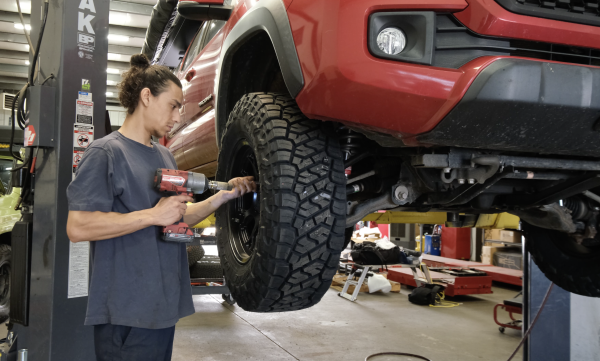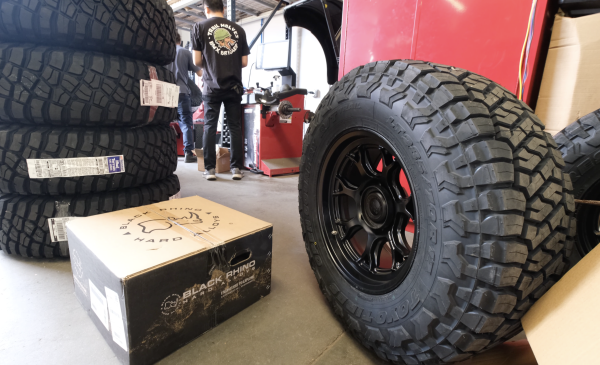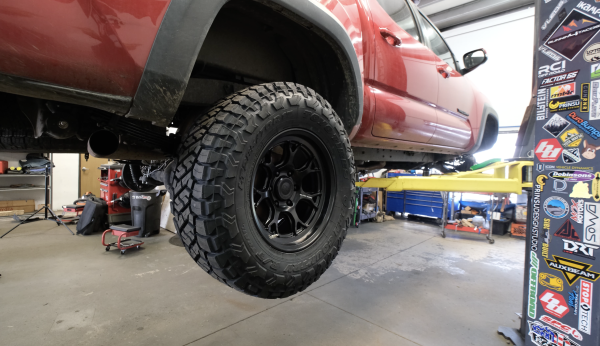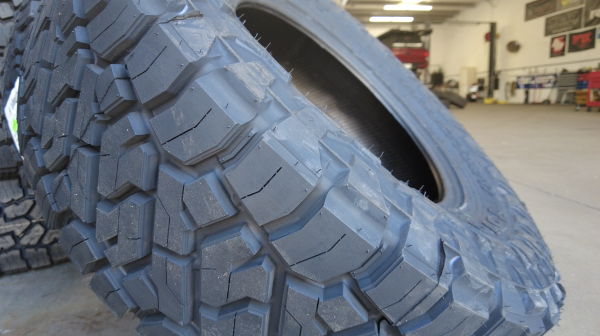That’s because Vo prefers practical overland builds rather than showy ones. He and I are very much alike in that regard, which is why I feel fortunate to have chatted with him about upgrades to my 2019 Toyota Tacoma TRD Off-Road. In the process of upgrading my suspension, I knew it was time for new tires. And Vo helped me choose the right tires not only for off-road performance, but also for on-road excellence.
If we’re all being honest with ourselves, that’s an important balance, since the vast majority of us spend the vast majority of our time driving on pavement. Yes, we want and need aggressive tires when the road turns to dirt, but even getting to the dirt usually requires miles and miles of pavement driving.
I spent the day at Runnin4Tacos recently, and spoke with Vo about what to look for when it’s time to upgrade your overland vehicle’s tires. Not surprisingly, Vo’s recommendations are all about practicality rather than show.
What tire size should you run for overlanding?

If you’re considering changing to a different tire size than the stock tires you already have, you’ll need to pay attention to a few other space considerations.
The first big consideration is your suspension setup. If you’re keeping your stock setup, you’ll be limited on how big you can go. In this case, it’s best to stick to the vehicle manufacturer’s recommendations.
If you’re putting a lift on the truck, you can definitely move to a bigger tire. But, depending on how big you want to go, you may end up needing upper control arms, and you may need to cut the trim around your wheel wells to accommodate the bigger rubber.
Finally, you may need new wheels, especially if you’re going to a wider tire. Your stock wheels may not have enough offset to push the tire outward. If they don’t, you’ll end up rubbing for sure.
All that is to say, you can definitely up your tire size, but unless you’re driving off-road in crazy conditions for the majority of your driving, you don’t need to go crazy. A little bit of added height goes a long way to changing the characteristics of your vehicle’s ride.
For example, my suspension upgrade added a two inch lift to my truck. That gave me the leeway to go from a 265/75R16 size tire to a 285/70R17 size Toyo Open Country R/T Trail tire with much more tread.
This size hits a nice balance between off-road performance and on-road tameness. I did go from a 16-inch wheel to a 17-inch wheel (more on that in a moment). But with these slightly larger tires, I get more grip, especially if I lower my tire pressure off-road. And I didn’t have to go to massive tires with mud-terrain treads to do it. While those big, beefy tires look cool and may be the right choice for some off-roaders, I spend too much time on pavement for those types of tires to make sense.
As always, it boils down to an honest conversation with yourself about how you drive, where you drive, and what type of handling you’re looking to get out of your vehicle.
What wheel size should you choose for your off-road tires?

I could have stuck with 16-inch wheels. In fact, if I was doing the majority of my driving off-road, the 16-inch wheels might have been a better choice, since that would give me more tire sidewall length. More sidewall means more traction and compliance at lower pressures, something you’ll need on gnarly off-road terrain.
But with the larger tires I put on my truck, the bump up to 17-inch wheels made sense for me. Again, because I do a lot more driving on pavement than I do off-road, I wanted to be sure I got plenty of cornering stability out of my tires. A taller rim will help provide that by reducing the sidewall height, thereby reducing tire lean in corners.
Plus, 17-inch wheels have become the wheel size du jour among off-roaders and overlanders, especially as tires get bigger. That means you’ll have a better selection of tires to choose from.
It’s important to note that the offset of the Black Rhino Etosha wheels I chose is very different from my stock Tacoma wheels. On the stock wheels, the outer sidewall of my tires sat all but flush with the outside of the wheel rim because the wheels have a positive offset. The Black Rhino wheels have a negative offset that pushes the tire outward to prevent rubbing, and giving the truck a (very) slightly wider stance.
Pay close attention to wheel offsets when you’re choosing your wheel and tire combo. This can make or break the performance of your rubber. If you’re unsure what works with what, there’s no shame in asking the pros.
But generally, if you’re adding width to your tires, you’ll probably need wheels with a negative offset. There are wheels with all sorts of offset measurements, and you’ll want to choose the offset that plays nicely with your tires and suspension.
Do you need e-rated tires?

If you have a heavy setup like I do, you’ll want an e-rated tire to help support that load. E-rated tires feature more plies in the tire’s construction — layers that overlap to give the tire more strength and structure.
The Toyo tires I chose are E-rated, which means they have a 10-ply construction. Most light trucks like mine use a C-rated tire, which is a 6-ply construction.
Most drivers won’t need a tire with 10-ply construction and can safely use a 6-ply tire. There are benefits to going with lower ply tires: they will offer more compliance and grip, and a softer ride. But, if you’re loaded down all the time with heavy items like a camper shell, drawer system, rooftop tent, rooftop boxes, tools, camping gear, gas, water, fridges — you get the idea — it’s very possible that E-rated tires are in your future.
Tire manufacturers will generally have weight guidelines on their websites to give you a sense of when E-rated tires are needed. Just keep in mind that those weight recommendations refer to full-time weight — the weight of the stuff you always keep on your truck. If you’re strapping on all the special toys only occasionally, you probably don’t need tires this burly.
Bonus recommendation: if you’re hauling a lot of weight full-time, consider upgrading your leaf springs. You can read more about that, and suspension upgrades, in our guide to suspension upgrades here.
What kind of tread is best for off-road driving?

A tire’s tread has a massive effect on its ability to grip the pavement and the dirt. Finding the right tire to accommodate both styles of driving can be tough. But Vo says he starts his tire search by looking at a key feature.
“Siping is the most important thing I look for in a tire,” says Vo. “Most of us drive our vehicles on road and take adventures on the weekend,” so it makes sense to ensure your tires have siping that will make your tires excel at pavement driving.
That siping will expel rain and snow to help ensure grip on pavement, especially during hard braking. So it’s a vital feature not only for performance, but also safety.
From there, Vo recommends looking at tires that will give you enough traction off-road for your weekend adventures, but not so much tread that your head will be thrumming from the noise on pavement. All-Terrain tires usually strike this balance.
Sidewall tread is also important, and more than just a visual cue. Those sidewall treads will give you more grip when driving on off-camber roads and trails, or rock crawling. These treads can become especially important if you drop your tire pressure; the sidewall will conform to obstacles, and these treads will in turn conform to obstacles and provide extra grip.
Putting it all together to choose the best tire
Jeez, all you wanted to do was walk into the shop, point to some tires, and get rolling again! Yes, it’s more complicated than that, but fortunately, you can still just walk into a shop and start pointing — as long as you trust that shop and the folks running it.
The best way to ensure your new tires play nicely with your wheels and suspension is to form a solid relationship with your local shop, especially if you’ll be doing a lot of other upgrades to your truck. Tuan Vo’s team at Runnin4Tacos gave me honest and useful information about upgrades to my truck that would be worth the money, and what upgrades would just be for show. It’s a good indication that this shop is worth my repeat business.
But if you want to do it all yourself, start by making a list of your truck’s setup. What suspension do you have? What size wheels do you have, paying close attention to offset? How much tire can your setup clear? What type of driving will you be doing mostly, and what will you be doing only some of the time?
Run down that list and you’ll arrive at a solid answer for choosing the best tires for your off-road rig. When in doubt, search for A/T, or all-terrain, tires. These usually hit the right balance between on- and off-road performance. But before you hit that big, beautiful BUY button, it might be a good idea to consult the experts at your local shop so you don’t waste a weekend trimming away at your wheel wells, or spending even more money on upper control arms and other bits you’ll need to properly space your big tires.
]]>



